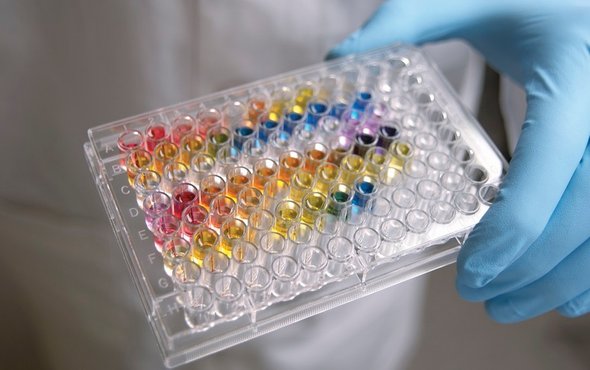(单词翻译:单击)
听力文本
This is Scientific American — 60-Second Science. I'm Deboki Chakravarti.
Chemists come up with new substances every year to go in everything from makeup to medicines. But introducing these chemicals into products also raises questions about their potential dangers. Can they irritate the skin? The eyes? Could they damage DNA?
To identify these possible risks, companies often test chemicals on animals. But these trials are expensive and time-consuming, and the results aren't always reliable. Plus, many consumers are uncomfortable with their favorite products being tested on animals—like mice, rabbits, and guinea pigs.
But we may be able to avoid animal tests without sacrificing the ability to forecast problems. Because researchers have developed a computer program that can predict the toxic effects of new chemicals better than animal testing can.

The method relies on a database that the scientists created that includes the results of more than 800,000 animal tests documented in various toxicology registries, covering about 10,000 chemicals.
Such databases make it possible for an expert to anticipate the dangers of an untested chemical by comparing it to similar chemicals. This process is called "read-across," and it is the main alternative to animal testing. But read-across is subjective. Different people might choose different comparison chemicals based on what compounds they're familiar with. They could even come to opposing conclusions.
So, to remove that subjectivity, the researchers programmed a computer to do read-across on their database for them. Their method uses machine learning algorithms to compare the structures and toxic effects of different chemicals. The result is a sort of map of chemical structures and properties that allows them to predict the potential toxic effects of a new chemical based on where it sits on that map.
And this method enabled the scientists to predict a chemical's dangers more accurately than did some of the most commonly used animal tests. Their results are detailed in the journal Toxicological Sciences.
The software is being made commercially available by Underwriter's Laboratories, which co-sponsored the research. Given that computer programs don't need the money or time to run that animal experiments do, this virtual toxicology screening should appeal to companies and animal lovers alike.
Thanks for listening for Scientific American — 60-Second Science. I'm Deboki Chakravarti.
参考译文
这里是科学美国人——60秒科学。我是黛博奇·查克拉瓦蒂。
化学家每年都会提出新成分,添加进从化妆品到药品的各种产品中。但是将这些化学物质引入产品中也引发了对其潜在危险的质疑。这些物质会刺激皮肤吗?会刺激眼睛吗?它们会损害DNA吗?
为了确定这些潜在的风险,公司经常在动物身上测试化学物质。但这些试验既昂贵又耗时,而且结果也并不总是可靠的。此外,许多消费者对他们最爱的产品在老鼠、兔子、豚鼠等动物身上进行测试感到不舒服,
但是我们也许能够在不牺牲预测问题能力的前提下避免动物实验。因为研究人员开发出了一种计算机程序,能比动物试验更好地预测新化学物质的毒性反应。
这种方法依靠科学家创建的一个数据库,该数据库包括记录在各种毒物学资料库中的80余万份动物试验结果,涵盖约1万种化学物质。
此类数据库使专家能通过将未经测试的物质物质与类似化学物质进行比较,来预测前者的危险性。这一过程被称为“交叉参照”,是动物实验的主要替代方法。但交叉参照具有主观性。不同的人可能会基于自身熟悉的化合物,来选择不同的对照化学物质。他们甚至可能会得出相反的结论。
因此,为了消除这种主观性,研究人员设计了一个电脑程序,用它在数据库上代替人进行交叉参照。他们采取的方法是,用机器学习算法来比较不同化学物质的结构和毒性反应。其结果是一张关于化学结构和性质的地图,这使科学家可以依据一种新化学物质在地图上的位置来预测其潜在的毒性反应。
与最常使用的动物试验相比,这种方法使科学家能够更精准地预测一种化学物质的危险性。具体研究结果发表在《毒物科学》期刊上。
该软件已由研究共同赞助方“美国保险商实验室”投入市场。考虑到该计算机程序不用动物试验所需的资金或时间来运行,这种虚拟毒性筛查应该对公司和动物爱好者都有吸引力。
谢谢大家收听科学美国人——60秒科学。我是黛博奇·查克拉瓦蒂。
译文为可可英语翻译,未经授权请勿转载!
重点讲解
重点讲解:
1. come up with 想出,提出(计划、想法等);
No one has come up with a definitive answer as to why this should be so.
对于为什么应该是这样,还没有人想出最终确定的答案。
2. rely on 依赖;依靠;
You can't rely on any figures you get from them.
你不能相信从他们那儿得到的任何数据。
3. compare to 比较;对比;
Note how smooth the skin of the upper arm is, then compare it to the skin on the elbow.
请注意上臂的皮肤是多么光滑,然后把它和肘部的皮肤比较一下。
4. appeal to 对…有吸引力;使感兴趣;
On the other hand, the idea appealed to him.
从另一方面来说,这个想法又使他很感兴趣。


